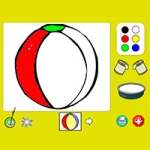
 |
Mixing Paint |
Children love to mix colours when painting. Some will tackle it with enthusiasm and are willing to experiment, often surprising themselves with the results. Other children will stick with colours they are familiar with and have used before.
This game has two modes, free and directive play. The free play mode allows creativity and experimentation, perfect for younger children. The directive mode is great for children looking for a challenge as it involves advanced observation and cognitive skills.
There are fifteen lovely designs from which to choose.
Bottom toolbar
| Mode - directive | |
| Mode - free play | |
| Restart | |
| Template - disappears in free play mode | |
| Arrows - move between screens | |
| Exit |
Right side toolbar
| Colour palette | |
| Mixing area - pots and mixing bowl |
On opening the game children will be taken into the directive mode. They will see a black and white picture in the main part of the screen. The same picture is below it, only smaller and coloured (template). The aim in this mode is to colour the larger picture exactly the same as the template.
If colours are placed incorrectly or the wrong colour used, the area will return to white.
In directive mode, when the picture is successfully completed, a fanfare sounds. New pictures can be chosen by clicking on the forward arrow on the bottom toolbar.
To paint, click on a coloured circle on the colour palette and then click on an unpainted area in the big picture. The bristles on the brush indicate the active colour.
To mix colours, click on a colour from the palette and then click on a paint pot. Repeat with the other paint pot. Click on the mixing bowl under the pots. The paints will pour into the bowl and become the new colour. The brush will now take on the new colour.
Coloured pictures are not erased on completion. Click on the restart icon to clear the colours.
In free play, there is no template to follow. Children can mix paints and colour as they please. They can click on the forward arrow to move onto a new picture at any time.
To exit, click on the small hand in the lower right corner of the screen.
Outcome 4: Children are involved and confident learners
Outcome 5: Children are effective communicators
Colours
Knowledge of colour combinations
Colouring with a fill tool
Experimentation
Observation
Same and different
Creativity
Decision-making
Mouse control - single click
Mixing colours is a skill that is learnt through experience. The more practice that children have, the easier they will find it. Some colours are easier to remember how to create than others. For example, colours that we would call a light or dark shade simply have white or black paint mixed with them. So, light blue is blue with white added. Dark green is green with black added.
To gain confidence with mixing colours, encourage children to try the free play mode first. Initially they may just use the colour palette. Show them how to use the mixing pots and let them experiment. Suggest possible combinations for them to try. See if children can guess what colour will result before they click on the bowl.
In the directive mode, show children the smaller template picture and explain that they need to colour the larger picture exactly the same. Some children will select or make a colour and then find all the areas that need that colour. Others will colour one area at a time, thus needing to constantly change their brush colour. Children should be encouraged to use whichever method they are comfortable with.
If children are finding it difficult to mix a certain colour, help them by suggesting one of the colours needed. Encourage them to keep trying as they mix, praise their efforts and applaud as they complete the puzzle.